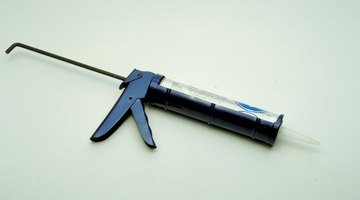Proper Caulking of Cement Siding
Fiber cement siding is a very popular alternative to other types of available siding today. According to the Portland Cement Association's estimate, 12 to 15 percent of new homes are currently clad with fiber cement siding. Siding manufacturers offer warranties extending to between 30 and 50 years.

However, every manufacturer warranty insists on proper installation or the warranty is void. Proper installation of fibrous cement siding includes proper caulking techniques during installation.
What is Caulk?
Caulk is a semi-liquid finishing material used to seal gaps between various construction materials. It is used to prevent air and moisture leaks, which can damage surfaces under or around the gaps. Purchasing caulk can be confusing, because there are so many types and quality grades to choose from.
Using the wrong caulk when you are installing cement siding will void the manufacturer’s warranty. Cement siding manufacturers recommend caulk types, and sometimes a specific caulk brand. Concrete siding manufacturer recommendations include acrylic, latex and urethane caulks.
An important thing to remember is that the caulk you use must be able to accept paint (some do not). Caulk is exposed to sunlight, temperature extremes and other weathering factors every day. Use the best grade of caulk available, to reduce the amount of maintenance you will need to perform in the future.
Caulk is packaged in tubes and requires the use of a caulk gun to get it out of the tube. Cut the plastic tip of the caulk tube with a razor knife on a 45-degree angle. The further from the tip you make the cut, the wider the caulk bead will be as it comes out of the tube. Make the cut about ½ inch from the end of the tip; this will produce a ¼-inch caulk bead. Some brands of caulk include a membrane barrier inside the caulk tube at the base of the plastic tip. You will need to puncture the membrane with a nail or a piece of wire before any caulk will come out of the tube. Squeezing the trigger of the caulk gun pushes caulk out of the tip of the tube.
How is it Done?
The ends of the siding boards are called “butt” ends. You should apply caulk to the gaps between the siding butt ends and the trim, and to the gaps at the butt joints of any two pieces of siding. Use your finger to push the caulk deep into the gap. You will produce a smooth, rounded finish to the caulk when you do it properly.
Avoid the big mistake. To properly install cement siding, you must caulk each row of siding before you install the next row of siding. If you wait until all of the siding is installed to apply the caulk, you will leave sections of every gap without caulk in them. The problem is that each row hangs over the row beneath it; this is called a “lap.” It is more time consuming to properly caulk the siding in this way, but by doing so you reduce the chances of leaks, and you keep the manufacturer’s warranty in force.
It is not necessary to caulk the “shadow line” of the lap (the gap between an overhanging row of siding and the row directly under it). Caulking the lap is an expensive waste of material, and can potentially be a problem. One purpose of the gap is to provide a way out for any water that might get between the siding and the moisture barrier.
References
Resources
Writer Bio
Fred Howe, a writer since 2009, holds a B.S. in sociology from George Fox University. A retired correctional officer from Pelican Bay State Prison in California, Howe has also worked as a sous chef and catering manager.
Photo Credits
- Ablestock.com/AbleStock.com/Getty Images
- Ablestock.com/AbleStock.com/Getty Images
More Articles



